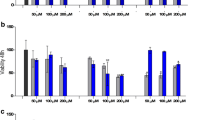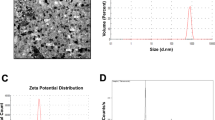Abstract
Available cancer therapies are limited due to undesirable side effects, non-specific cellular toxicity as well as treatment failure. Therefore, there is urgent need for newer treatment strategies. In this study, we comparatively determined the in vitro anti-cancer potential of inorganic nanoparticles (NPs) in MDA-MB-231 cancer cells. Flow cytometry, confocal microscopy, and reactive oxygen species (ROS) assays were employed to probe likely mechanism of anti-cancer action of NPs. Study demonstrated dose-dependent toxicity of NPs to MDA-MB-231 cells. The NPs promoted production of ROS and might have caused early apoptotic clearance of MDA-MB-231 cells. Considered together, the findings support anti-cancer potential of inorganic NPs. Furthermore, preliminary evidence suggests that the anti-cancer potential of these NPs may be linked with capacity to cause ROS production as well as cellular apoptosis. Further studies to clearly define the mechanistic cellular actions of these nanoparticles are warranted.





Similar content being viewed by others
References
Adeyemi O, Whiteley C (2013) Interaction of nanoparticles with arginine kinase from Trypanosoma brucei: kinetic and mechanistic evaluation. Int J Biol Macromol 62:450–456
Adeyemi O, Whiteley C (2014) Interaction of metal nanoparticles with recombinant arginine kinase from Trypanosoma brucei: thermodynamic and spectrofluorimetric evaluation. Biochim Biophys Acta 1840:701–706
American cancer society (2018) How Common Is Breast Cancer? https://www.cancer.org/cancer/breast-cancer/about/how-common-is-breast-cancer.html. Accessed 4 Mar 2018
Asharani P, lianwu Y, Gong Z, Valiyaveettil S (2010) Comparison of the toxicity of silver, gold and platinum nanoparticles in developing zebrafish embryos. Nanotoxicol 5:43–54
Azizi M, Ghourchian H, Yazdian F, Bagherifam S, Bekhradnia S, Nyström B (2017) Anti-cancerous effect of albumin coated silver nanoparticles on MDA-MB-231 human breast cancer cell line. Sci Rep 7:5178
Azizi M, Ghourchian H, Yazdian F, Alizadehzeinabad H (2018) Albumin coated cadmium nanoparticles as chemotherapeutic agent against MDA-MB-231 human breast cancer cell line. Artif Cells Nanomed Biotechnol 46:1–11
Bhattacharya R, Mukherjee P (2008) Biological properties of “naked” metal nanoparticles. Adv Drug Deliv Rev 60:1289–1306
Centers for Disease Control and Prevention (2018) Breast cancer in young women https://www.cdc.gov/cancer/breast/young_women/bringyourbrave/pdf/breastcanceryoungwomenfactsheet.pdf. Accessed 3 Mar 2018
Duangmano S, Sae-lim P, Suksamrarn A, Domann F, Patmasiriwat P (2012) Cucurbitacin B inhibits human breast cancer cell proliferation through disruption of microtubule polymerization and nucleophosmin/B23 translocation. BMC Complement Altern Med 12:185
Gurunathan S, Han J, Eppakayala V, Jeyaraj M, Kim J (2013) Cytotoxicity of biologically synthesized silver nanoparticles in MDA-MB-231 human breast cancer cells. Biomed Res Int 2013:1–10
Krishnaraj C, Muthukumaran P, Ramachandran R, Balakumaran M, Kalaichelvan P (2014) Acalypha Indica Linn: biogenic synthesis of silver and gold nanoparticles and their cytotoxic effects against MDA-MB-231, human breast cancer cells. Biotechnol Rep 4:42–49
Kumar V, Yadav S (2009) Plant-mediated synthesis of silver and gold nanoparticles and their applications. J Chem Technol Biotechnol 84:151–157
Meyer J (2017) Silver nanoparticles are in general more toxic to C. elegans than tested gold, copper, iron, titanium dioxide, zinc oxide, cerium oxide, and carbon-based nanoparticles http://wbg.wormbook.org/2017/01/17/silver-nanoparticles-are-in-general-more-toxic-to-c-elegans-than-tested-gold-copper-iron-titanium-dioxide-zinc-oxide-cerium-oxide-and-carbon-based-nanoparticles/. Accessed 4 Mar 2018
Moses SL, Edwards VM, Brantley E (2016) Cytotoxicity in MCF-7 and MDA-MB-231 breast cancer cells, without harming MCF-10A healthy cells. J Nanomed Nanotechnol 7:369
Shrivastava R, Kushwaha P, Bhutia Y, Flora S (2014) (2014) Oxidative stress following exposure to silver and gold nanoparticles in mice. Toxicol Ind Health 32:1391–1404
Thoidingjam S, Tiku A (2017) New developments in breast cancer therapy: role of iron oxide nanoparticles. Adv Nat Sci Nanosci Nanotechnol 8:023002
Toyokuni S, Okamoto K, Yodoi J, Hiai H (1995) Persistent oxidative stress in cancer. FEBS Lett 358:1–3
Wang W, Zhang L, Chen T, Guo W, Bao X, Wang D, Ren B, Wang H, Li Y, Wang Y, Chen S, Tang B, Yang Q, Chen C (2017) Anticancer effects of resveratrol-loaded solid lipid nanoparticles on human breast cancer cells. Molecules 22:1814
Warleta F, Quesada C, Campos M, Allouche Y, Beltrán G, Gaforio J (2011) Hydroxytyrosol protects against oxidative DNA damage in human breast cells. Nutrients 3:839–857
Yuan Y, Peng Q, Gurunathan S (2017) Combination of palladium nanoparticles and tubastatin-A potentiates apoptosis in human breast cancer cells: a novel therapeutic approach for cancer. Int J Nanomedicine 12:6503–6520
Acknowledgements
Authors acknowledge the Department of Biochemistry and Microbiology, Rhodes University, South Africa.
Author information
Authors and Affiliations
Corresponding author
Ethics declarations
Conflict of interest
The authors declare that they have no conflict of interest.
Ethical approval
This article does not contain any studies with human participants or animals performed by any of the authors.
Rights and permissions
About this article
Cite this article
Adeyemi, O.S., Otohinoyi, D.A. Inorganic nanoparticles restrict viability of metastatic breast cancer cells in vitro. Comp Clin Pathol 28, 949–954 (2019). https://doi.org/10.1007/s00580-018-2841-z
Received:
Accepted:
Published:
Issue Date:
DOI: https://doi.org/10.1007/s00580-018-2841-z




